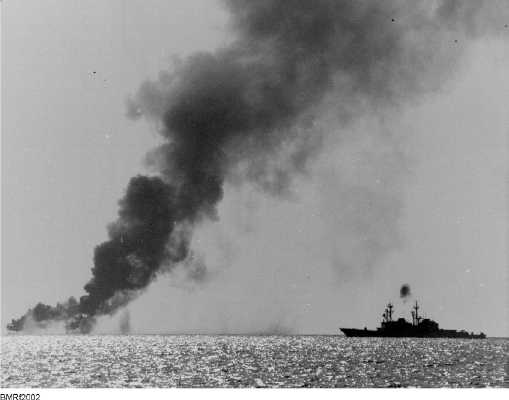must block the enemy’s sea-lanes and sink its merchant
ships and transports.
In recent years, we have exercised control of
sea-lanes in the Middle East. During the 1987-1989
“tanker wars” in the Persian Gulf (fig. 20-2), the U.S.
Navy protected merchant ships and oil tankers flying
the U.S. flag. In 1990, we conducted a naval blockade of
Iraq to enforce United Nations sanctions following
Iraq’s invasion of Kuwait.
The Navy also provides forces for joint amphibious
operations. It trains all forces assigned to these
operations in amphibious warfare as directed by the
Joint Chiefs of Staff. It also conducts naval
reconnaissance, antisubmarine warfare, mine laying
and controlled mine-field operations, and protects
shipping. Operation Desert Shield/Storm is a typical
example. The Navy joins with the other services in
defending the United States against air attack.
As you can see, the Navy’s mission is very complex.
As a result of that complexity, the United States is
undertaking a massive modernization of Navy ships,
aircraft, and weapons in three forms. The first involves
the speedup of research and development to find new
weapons. The second entails the laying up of old ships
to save operating and overhauling costs and the shifting
of that money into new construction. The third consists
of the “hi-low balanced mix” concept. That concept
involves the purchase of a few highly effective aircraft
and ships, such as nuclear propulsion aircraft carriers
(CVNs) and submarines (SSBNs). At the same time, we
are developing new classes of low-cost ships, such as
guided-missile frigates and sea-control ships.
Our nuclear-age world has resulted in a nuclear-age
Navy. Although the Navy uses nuclear weapons and
guided missiles as its primary destructive weapons, it
still maintains, and is improving, conventional
weapons. Such weapons enable the Navy and Marines
to rapidly deploy and to apply the necessary force to
fight a limited war.
The Navy leads the way in scientific projects. In the
area of navigation, Navy ships can navigate on and
under the oceans for days at a time. They no longer rely
on traditional sources such as landmarks and stars to fix
20-5
Student Notes:
Figure 20-2.—U. S. ships blowing up an oil platform in the Persian Gulf.

